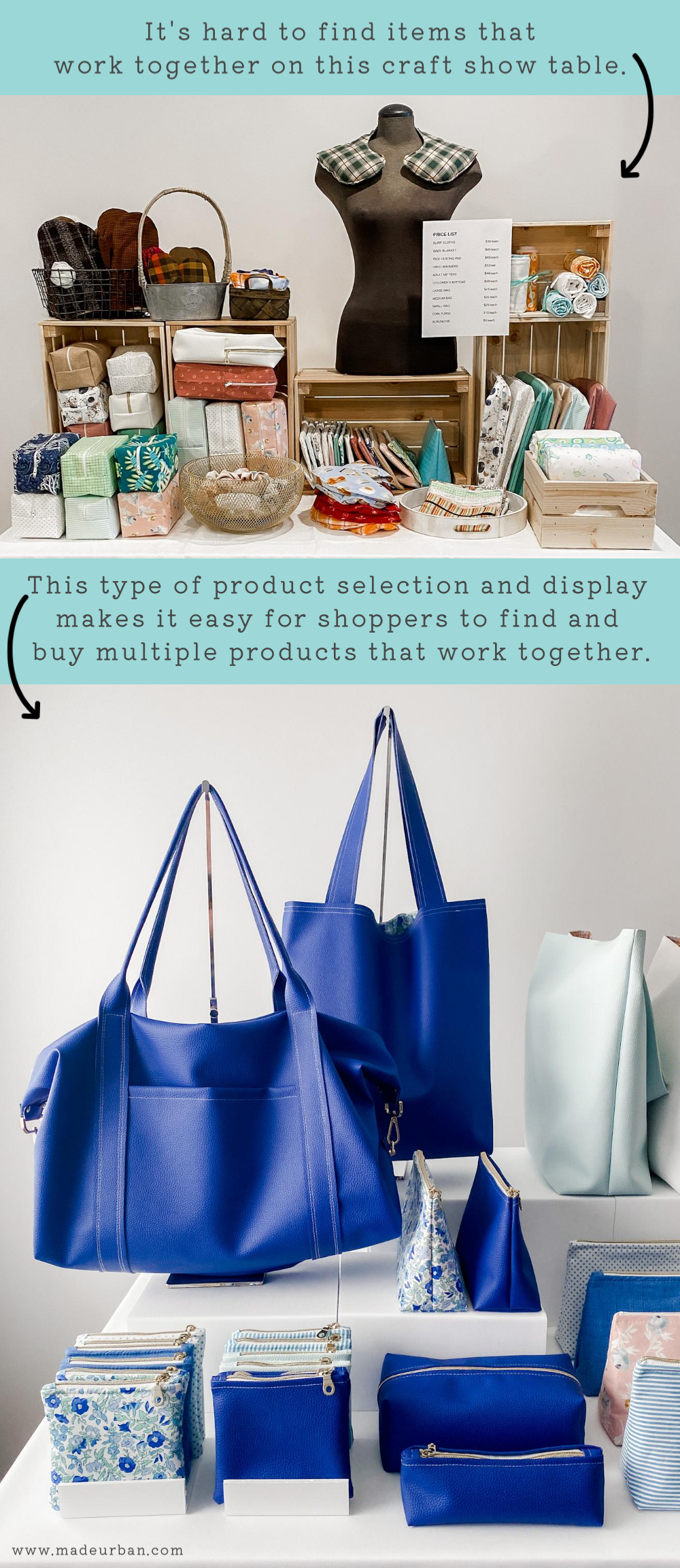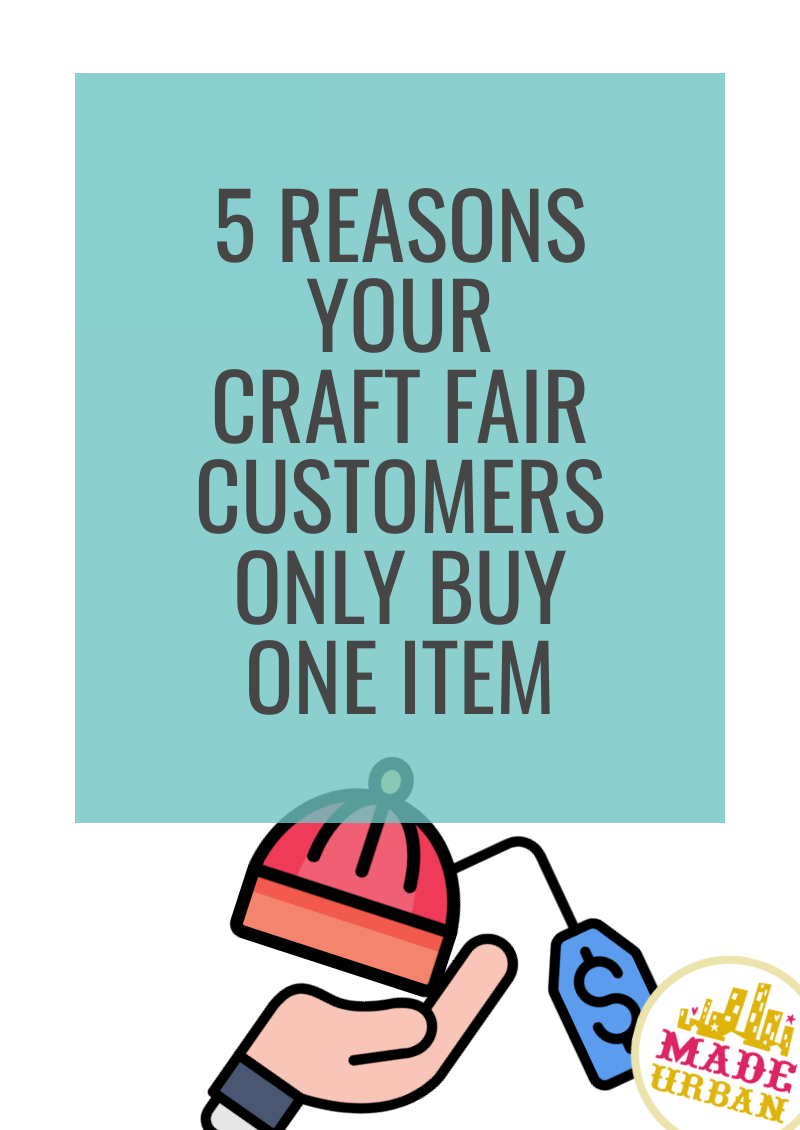5 Reasons Your Craft Fair Customers Only Buy One Item
When you’re selling at a craft show, it’s important to optimize sales.
Selling two items to each customer is better than selling one item to each customer.
Even if a customer only buys one item at the event, the right strategy can encourage them to buy another item from you after the event and become a repeat customer.
If your customers tend to only buy one item, you may be making one or more of these mistakes.
1) No price point variation
Although it does happen, most people aren’t going to buy two higher-priced items in one transaction.
So if all your products are similar in price, you may be deterring multi-item purchases.
The easiest way to increase your units per transaction is to offer “no-brainer” purchasing options.
These should be low-priced and work with your main seller to complete it, enhance it, or care for it.
Of course, your add-on items can be bigger and more expensive.
The key is to have product options that are at least half the price of your main products, so customers feel comfortable adding more items to their order.
2) Not enough product variation
It is possible to offer price variation without introducing new products (e.g. offering the same product with different features, using different materials, in different sizes, etc.).
But along with price point variation, you should also ensure you have product variation.
Let’s say I make aprons. I may offer bib aprons and waist aprons in a variety of styles and materials. Those different styles create price variations.
However, a customer buying a bib apron is unlikely to also want a waist apron.
In this scenario, I would want to introduce products that my customers might want to buy with a bib or waist apron.
That might be matching:
- oven mittens
- pot holders
- tea towels
It’s important to be focused when developing your product line for a craft show and don’t get too broad. Stick to products that can be mixed and matched to work together.
3) You don’t know your target market
When I find a business/brand I love, there are almost too many products that appeal to me; I want everything they sell. It feels like that business gets me and it’s a perfect match for my style.
On the other hand, when I come across businesses that have one or two items I like, but the rest is not my style, not only do I not want to buy multiple items, but I also question buying the items I do like.
There’s something that feels inauthentic about a business trying to appeal to too many types of customers.
It’s like a person who wants everyone to like them so they’re never themselves. It’s hard to know what’s real and what’s fake and they end up driving everyone away.
When you go after too many types of customers, you can’t create a product line that encourages multi-item purchases. You fill your table with too much variation and throw off your brand and ultimately, your customers.
Get focused with your target market and get to know them.
It will help you develop a product line that makes them want one of everything.
4) Nothing matches
People tend to focus on one purpose when they’re shopping.
For example, they’re shopping for jewelry, or home decor items, or skincare, but not all three at once.
So if your craft show table is filled with products from different categories or subcategories, shoppers will have a hard time finding more than one item they want to purchase at once.
Even when within a shopping subcategory (e.g. Accessories -> Jewelry), you have to make it easy for people to match items.
For example, if I’m selling jewelry, I’d want to limit how much variation I offer so it’s easy for shoppers to find the gold & pearl earrings that match the gold & pearl necklace.
Too many matching options can have the opposite effect and cause decision fatigue.
For example, if a pearl necklace has 10 different types of matching pearl earrings, shoppers may have a hard time deciding between them, and decide not to buy any of the earrings.
Make sure you develop a signature style so there is cohesion from one product to the next and it’s easy for your customers to find multiple items that work together.

5) Hard-to-shop display
How you merchandise your stock on a craft fair table also plays a role in whether people buy one item or multiple items.
If I’m selling a pearl necklace and it has matching earrings, but those earrings are on the other side of the table, and/or displayed with a variety of other earrings, shoppers are likely to miss them.
At a busy event, you can’t speak to every shopper. And even if you can, you won’t always be able to pick up on a shopper’s cues.
Many people shop with their eyes and not their hands. So a shopper may be interested in an item (e.g. the pearl necklace) but never pick it up (which would be your cue to let them know you have matching earrings). If they’re scanning the table for a matching pair of earrings, but they can’t see them, they may decide not to buy.
A craft show table stuffed with too much inventory can also make it harder for shoppers to find items.
Too many items and too many colors/patterns/scents etc. can overwhelm shoppers.
Refine your product line, limit how much stock you display, and create product compositions that make it easy for shoppers to see and buy items that are ideal to be purchased together.


Hey, I’m Erin 🙂 I write about small business and craft show techniques I’ve learned from being a small business owner for almost 2 decades, selling at dozens of craft shows, and earning a diploma in Visual Communication Design. I hope you find my advice helpful!
